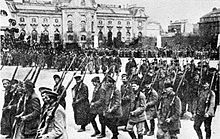Soviet Latvian Army
The Soviet Latvian Army (Latvian: Padomju Latvijas armija) was the armed force of the Latvian Soviet Socialist Republic in 1919 . It was in fact under the command of the Red Army and was incorporated into it after the loss of Latvian territory. The Baltic State Armed Forces and the Estonian Army fought against the Soviet Latvian Army .
Origin and composition
By resolution of the Revolutionary War Council of the LSSR, the army was established on January 4, 1919 after the capture of Riga . The 1st Soviet Latvian Rifle Division , the International Division and the Liepāja and Saratov regiments were subordinated . From the latter regiments and drafted Latvian soldiers, the formation of a 2nd Soviet Latvian Rifle Division began. At times the 2nd Novgorod Division and the Lithuanian Rifle Division were also under the command of the army. Whenever possible, units of the Latvian red riflemen that were still deployed in Russia were relocated to the Latvian front and incorporated into the army. By mid-May the army had reached a combat strength of around 45,000 people. The army inspector Reinholds Bērziņš put the workforce on May 14, 1919, including rear parts and army facilities, at 10,5000 people. In addition to the land units, there was also an air force with 18 aircraft and naval units for coastal protection. Unlike in the Red Army, elected soldiers' councils were represented in the Revolutionary War Council until it was dissolved in 1919 .
Calls
By February 1919, the imperial German and counter-revolutionary units could be pushed back to a small area around Liepāja. The first setbacks had to be accepted on the front in Estonia. In March the army withdrew from Courland, where an offensive took place under the command of Rüdiger von der Goltz . Attacks in southern Estonia were unsuccessful. After May 22, 1919, Riga and, soon after, southern Livonia had to be evacuated. During these operations the army lost around 60% of its workforce through desertion, wounding, death and capture. In the Daugavpils area, the remnants of the army were reorganized and on June 7th it was renamed the 15th Army .
Commander
- Jukums Vācietis (January 6, 1919 - March 10, 1919)
- Pēteris Slavens (March 10, 1919 - June 7, 1919)
literature
- Igors Vārpa: Latviešu karavīrs zem Krievijas impērijas, Padomju Krievijas and PSRS karogiem. Latviešu strēlnieki triju vēstures laikmetu griežos . Nordik, Riga 2006, ISBN 9984-792-11-0 .
- Claus Grimm: At the gates of Europe 1918–1920. History of the Baltic State Army . Velmede, Hamburg 1963.
- Inta Pētersone (ed.): Latvijas Brīvības cīņas 1918–1920 . Enciklopēdja. Preses nams, Riga 1999, ISBN 9984-00-395-7 .
Individual evidence
- ↑ Jānis Šiliņš: Padomju Latvija 1918-1919 Riga 2013, ISBN 978-993-483-9900 , p. 158
- ↑ Jānis Šiliņš: Padomju Latvija 1918–1919 Riga 2013, ISBN 978-993-483-9900 , pp. 167–170
